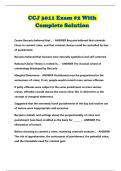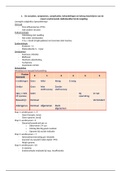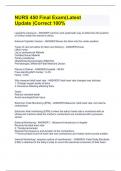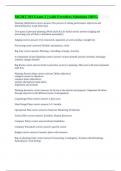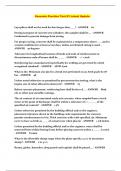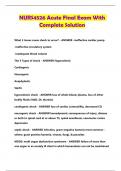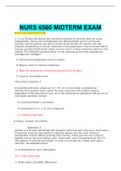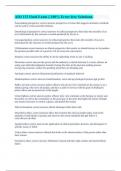Understanding Values
Week 2: User values
Intended user = target group; group in the marke3t that you focus on with a product/service/idea
Who is your user?
Variables of segmentation:
Geographic: cities, regions, world regions, identity factors (language, climate, lifestyle)
Demograpic: age ((e.g. generations) , gender, life-cycle stage, dwelling classification
Psychographic: values, beliefs, opinions, interests
Behavioural: occasions, benefits sought, usage rate, users status
What is their problem?
Needs vs wants: A need is something that is necessary to live and function. A want is something that
can improve your quality of life.
The value of a design outcome can be judged by how well the outcome solves problems and satisfies
needs.
Job-to-be-done = a problem encountered or a need
Clusters:
Functional: What does it help you do/achieve?
Emotional: How do you want to feel when you use/own it/
Social: What effect does owning/using must have on your (place In the) social system?
Pains: obstacles, challenges, annoyances, worries, …
Gains: easier, faster, better, cheaper, delights, …
Value proposition statement = the one sentence pitch on value for whom
The value (worth) of design outcomes for users (effect)
User value arises from interpretation and appropriation every designer anticipates on this
Design outcomes are never neutral values can be intentionally or unconsciously embodied; how
the design will promote or hinder certain values of a user is a result of a complex interactionThe
mediation theory = technologies, when they are used, help to shape relations between human beings
and the world
Delegation = deliberate inscription of intentionalities (amplification reduction) and scripts (invitations
and inhibitions) anti- of pro-zwerver bankjes
Design with intent: motivate (bv. energiebesparing), facilitate (bv. vlieg in wc), inhibit (bv. ov-poortjes)
Value types: functional, social, emotional, economic, symbolic, historical, cultural, aesthetic, political,
environmental, brand, …
, Means-end chain model:
Values and attitudes: Values are highly abstract, transsituational guides. Attitudes are tendencies to
evaluate something/someone positively or negatively. Values shape attitudes, and the
ambivalence in our attitudes
Cognitive dissonance = changing behavior/beliefs to address the discomfort of the inconsistency
between beliefs and/or behaviors
Addressing intra-personal tensions: resolve, moderate, trigger
TED talk on dialogues
Responsible management = the commitment to acknowledging the ethical and environmental impact
of business decisions, ensuring businesses make a positive and sustainable impact
Socratic dialogue: silence, trust, open mind, curiosity,
Week 2: User values
Intended user = target group; group in the marke3t that you focus on with a product/service/idea
Who is your user?
Variables of segmentation:
Geographic: cities, regions, world regions, identity factors (language, climate, lifestyle)
Demograpic: age ((e.g. generations) , gender, life-cycle stage, dwelling classification
Psychographic: values, beliefs, opinions, interests
Behavioural: occasions, benefits sought, usage rate, users status
What is their problem?
Needs vs wants: A need is something that is necessary to live and function. A want is something that
can improve your quality of life.
The value of a design outcome can be judged by how well the outcome solves problems and satisfies
needs.
Job-to-be-done = a problem encountered or a need
Clusters:
Functional: What does it help you do/achieve?
Emotional: How do you want to feel when you use/own it/
Social: What effect does owning/using must have on your (place In the) social system?
Pains: obstacles, challenges, annoyances, worries, …
Gains: easier, faster, better, cheaper, delights, …
Value proposition statement = the one sentence pitch on value for whom
The value (worth) of design outcomes for users (effect)
User value arises from interpretation and appropriation every designer anticipates on this
Design outcomes are never neutral values can be intentionally or unconsciously embodied; how
the design will promote or hinder certain values of a user is a result of a complex interactionThe
mediation theory = technologies, when they are used, help to shape relations between human beings
and the world
Delegation = deliberate inscription of intentionalities (amplification reduction) and scripts (invitations
and inhibitions) anti- of pro-zwerver bankjes
Design with intent: motivate (bv. energiebesparing), facilitate (bv. vlieg in wc), inhibit (bv. ov-poortjes)
Value types: functional, social, emotional, economic, symbolic, historical, cultural, aesthetic, political,
environmental, brand, …
, Means-end chain model:
Values and attitudes: Values are highly abstract, transsituational guides. Attitudes are tendencies to
evaluate something/someone positively or negatively. Values shape attitudes, and the
ambivalence in our attitudes
Cognitive dissonance = changing behavior/beliefs to address the discomfort of the inconsistency
between beliefs and/or behaviors
Addressing intra-personal tensions: resolve, moderate, trigger
TED talk on dialogues
Responsible management = the commitment to acknowledging the ethical and environmental impact
of business decisions, ensuring businesses make a positive and sustainable impact
Socratic dialogue: silence, trust, open mind, curiosity,

